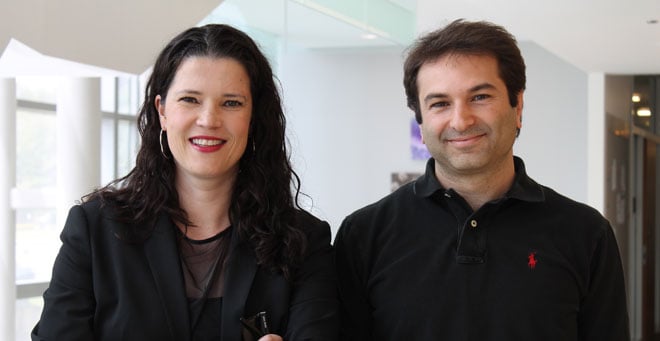 |
|
|
Marian Walhout, PhD, and Lutfu Safak Yilmaz, PhD |
Scientists at UMass Medical School have created a computational network model that will enable the unraveling of the mechanisms by which different macro- and micronutrients contribute to the physiology of the nematode C. elegans, which is a primary model for understanding human physiology and disease. The purpose of the new network, called iCEL1273, is to provide a framework to gain a broader understanding of the interactions between the animal and its bacterial diet.
“Our study is important because we want to understand not only the interactions between bacteria and animal cells, such as how they occur in our gut, but really how different nutritional components contribute to the generation of biomass or energy,” said Marian Walhout, PhD, professor of molecular medicine and co-director of the Program in Systems Biology.
Details of the iCEL1273 network (which contains 1,273 genes, 623 enzymes and 1,985 metabolic reactions) were published May 19 in the journal Cell Systems.
In the paper, Dr. Walhout and Lutfu Safak Yilmaz, PhD, research instructor in molecular medicine, present the first genome-scale reconstruction of the C. elegans metabolic network and show that by using iCEL1273, scientists can use mathematical simulation to convert bacterial diet into biomass.
“We’ve created a metabolic road map to interpret our findings in the lab and can go seamlessly back and forth between the animal and what it has ingested. We now have a computational way of converting diet into biomass and energy,” Walhout said.
Using a mathematical tool called flux balance analysis together with iCEL1273, scientists calculated various paths that nutrients, once consumed, could take in their conversion to biomass in the worm and what proportion of each route is used. They were also able to make predictions, at a systems level, of how a worm responds to individual nutrients, which could not be done solely by experiments in a wet lab, Walhout said.
The new network can be used as a confirmatory tool for work already completed in the lab, but more importantly, it can be used as a new predictive tool to interpret data and start new projects.
“We can computationally predict which genes in this metabolic network are essential for the worm to grow,” Dr. Yilmaz said.
The overarching vision for the new network is to gain a deeper understanding, both systemically and mechanically, the cause and effect of tinkering with bacteria that are eaten by the worm.
“This can provide hypotheses that we can then extrapolate and computationally test in the human network. It will allow us to see if and what we find in the interaction between bacteria and worms may translate to interactions between bacteria and human gut cells,” Walhout said.
Related links on UMassMedNow:
New strategy will allow scientists to map regulatory networks associated with complex multi-gene diseases
UMMS researchers develop model for isolating effects of nutrients on gene expression
You are what you eat—even the littlest bites: New UMMS research ties dietary influences to changes in gene expression
Newsmaker: Precise makeup of diet affects health in powerful ways, UMass worm research suggests